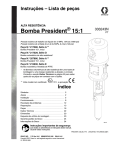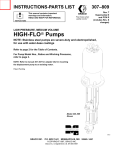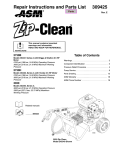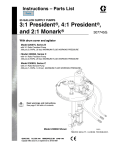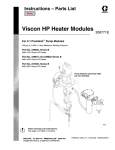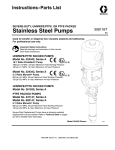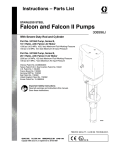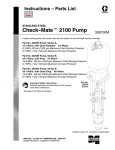Download Graco 306936N User's Manual
Transcript
Instructions – Parts List SEVERE DUTY 15:1 Ratio PresidentR Pump 306936N 1800 psi (12 MPa, 124 bar) Maximum Fluid Working Pressure 120 psi (0.8 MPa, 8.4 bar) Maximum Air Input Pressure Part 217580, Series A ** 15:1 Ratio President Pump, includes Part 217529, Series D Severe Duty Displacement Pump* Part 287886, Series A ** 15:1 Ratio President Pump, includes Part 215930, Series E PTFE Packed Displacement Pump * Severe-Duty Displacement Pumps have an abrasion and corrosion-resistant displacement rod and sleeve. Refer to Technical Data on page 22 for Wetted Parts information. ** This model is certified and approved. Table of Contents Symbols . . . . . . . . . . . . . . . . . . . . . . . . . . . . . . . . . . . . . . 2 Warnings . . . . . . . . . . . . . . . . . . . . . . . . . . . . . . . . . . . . . . 2 Installation . . . . . . . . . . . . . . . . . . . . . . . . . . . . . . . . . . . . . 5 Operation . . . . . . . . . . . . . . . . . . . . . . . . . . . . . . . . . . . . . 8 Troubleshooting . . . . . . . . . . . . . . . . . . . . . . . . . . . . . . . 12 Service . . . . . . . . . . . . . . . . . . . . . . . . . . . . . . . . . . . . . . 13 Parts . . . . . . . . . . . . . . . . . . . . . . . . . . . . . . . . . . . . . . . . 18 Technical Data . . . . . . . . . . . . . . . . . . . . . . . . . . . . . . . . 22 Dimensions . . . . . . . . . . . . . . . . . . . . . . . . . . . . . . . . . . . 23 Mounting Hole Layout . . . . . . . . . . . . . . . . . . . . . . . . . . 23 Graco Standard Warranty . . . . . . . . . . . . . . . . . . . . . . 24 Graco Information . . . . . . . . . . . . . . . . . . . . . . . . . . . . . 24 Important Safety Instructions Read all warnings and instructions in this manual. Save these instructions. GRACO INC.ąP.O. BOX 1441ąMINNEAPOLIS, MNą55440-1441 Copyright 2002, Graco Inc. is registered to I.S. EN ISO 9001 02113 Symbols Warning Symbol Caution Symbol WARNING CAUTION This symbol alerts you to the possibility of serious injury or death if you do not follow the instructions. This symbol alerts you to the possibility of damage to or destruction of equipment if you do not follow the instructions. WARNING EQUIPMENT MISUSE HAZARD Equipment misuse can cause the equipment to rupture or malfunction and result in serious injury. INSTRUCTIONS D This equipment is for professional use only. D Read all instruction manuals, tags, and labels before operating the equipment. D Use the equipment only for its intended purpose. If you are uncertain about usage, call your Graco distributor. D Do not alter or modify this equipment. Use only genuine Graco parts and accessories. D Check equipment daily. Repair or replace worn or damaged parts immediately. D Do not exceed the maximum working pressure of the lowest rated system component. Refer to the Technical Data on page 22 for the maximum working pressure of this equipment. D Use fluids and solvents which are compatible with the equipment wetted parts. Refer to the Technical Data section of all equipment manuals. Read the fluid and solvent manufacturer’s warnings. D Do not use hoses to pull equipment. D Route hoses away from traffic areas, sharp edges, moving parts, and hot surfaces. Do not expose Graco hoses to temperatures above 180_F (82_C) or below –40_F (–40_C). D Wear hearing protection when operating this equipment. D Do not lift pressurized equipment. D Comply with all applicable local, state, and national fire, electrical, and safety regulations. 2 306936 WARNING SKIN INJECTION HAZARD Spray from the gun, hose leaks, or ruptured components can inject fluid into your body and cause extremely serious injury, including the need for amputation. Fluid splashed in the eyes or on the skin can also cause serious injury. D Fluid injected into the skin might look like just a cut, but it is a serious injury. Get immediate surgical treatment. D Do not point the gun at anyone or at any part of the body. D Do not put your hand or fingers over the spray tip. D Do not stop or deflect leaks with your hand, body, glove or rag. D Do not “blow back” fluid; this is not an air spray system. D Always have the tip guard and the trigger guard on the gun when spraying. D Check the gun diffuser operation weekly. Refer to the gun manual. D Be sure the gun trigger safety operates before spraying. D Lock the gun trigger safety when you stop spraying. D Follow the Pressure Relief Procedure on page 8 whenever you: are instructed to relieve pressure; stop spraying; clean, check, or service the equipment; and install or clean the spray tip. D Tighten all fluid connections before operating the equipment. D Check the hoses, tubes, and couplings daily. Replace worn, damaged, or loose parts immediately. Permanently coupled hoses cannot be repaired; replace the entire hose. D Use only Graco approved hoses. Do not remove any spring guard that is used to help protect the hose from rupture caused by kinks or bends near the couplings. MOVING PARTS HAZARD Moving parts, such as the air motor piston, can pinch or amputate your fingers. D Keep clear of all moving parts when starting or operating the pump. D Do not operate the pump with the air motor plates removed. D Before servicing the equipment, follow the Pressure Relief Procedure on page 8 to prevent the equipment from starting unexpectedly. 306936 3 WARNING FIRE AND EXPLOSION HAZARD Improper grounding, poor ventilation, open flames or sparks can cause a hazardous condition and result in a fire or explosion and serious injury. D Ground the equipment and the object being sprayed. Refer to Grounding on page 5. D If there is any static sparking or you feel an electric shock while using this equipment, stop spraying immediately. Do not use the equipment until you identify and correct the problem. D Provide fresh air ventilation to avoid the buildup of flammable fumes from solvents or the fluid being sprayed. D Keep the spray area free of debris, including solvent, rags, and gasoline. D Electrically disconnect all equipment in the spray area. D Extinguish all open flames or pilot lights in the spray area. D Do not smoke in the spray area. D Do not turn on or off any light switch in the spray area while operating or if fumes are present. D Do not operate a gasoline engine in the spray area. TOXIC FLUID HAZARD Hazardous fluid or toxic fumes can cause serious injury or death if splashed in the eyes or on the skin, inhaled, or swallowed. D Know the specific hazards of the fluid you are using. D Store hazardous fluid in an approved container. Dispose of hazardous fluid according to all local, state and national guidelines. D Always wear protective eyewear, gloves, clothing and respirator as recommended by the fluid and solvent manufacturer. 4 306936 Installation NOTE: Reference numbers and letters in parentheses in the text refer to the callouts in the figures and the parts drawings. Grounding WARNING FIRE AND EXPLOSION HAZARD Before operating the pump, ground the system as explained below. Also read the section FIRE AND EXPLOSION HAZARD on page 4. NOTE: Always use Genuine Graco Parts and Accessories, available from your Graco distributor. If you supply your own accessories, be sure they are adequately sized and pressure-rated to meet the system’s requirements. Fig. 2 is only a guide for selecting and installing system components and accessories. Contact your Graco distributor for assistance in designing a system to suit your particular needs. 1. Pump: use a ground wire and clamp. See Fig. 1. Loosen the grounding lug locknut (W) and washer (X). Insert one end of a 12 ga. (1.5 mm2) minimum ground wire (Y) into the slot in lug (Z) and tighten the locknut securely. Connect the other end of the wire to a true earth ground. For a ground wire and clamp, order Part No. 237569. Z Prepare the Operator Y All persons who operate the equipment must be trained in the safe, efficient operation of all system components as well as the proper handling of all fluids. All operators must thoroughly read all instruction manuals, tags, and labels before operating the equipment. X W 0720 Fig. 1 Prepare the Site 2. Air and fluid hoses: use only electrically conductive hoses. Ensure that you have an adequate compressed air supply. Refer to the performance chart on page 22 to find the air consumption of your pump. 3. Air compressor: follow manufacturer’s recommendations. Mount the pump (V) to suit the type of installation planned. Fig. 2 shows the pump mounted on a wall bracket (U). The pump dimensions and mounting hole layout are shown on page 23. 5. Fluid supply container: follow your local code. 4. Spray gun: ground through connection to a properly grounded fluid hose and pump. 6. Object being sprayed: follow your local code. Keep the site clear of any obstacles or debris that could interfere with the operator’s movement. 7. Solvent pails used when flushing: follow your local code. Use only metal pails, which are conductive, placed on a grounded surface. Do not place the pail on a nonconductive surface, such as paper or cardboard, which interrupts the grounding continuity. Have a grounded, metal pail available for use when flushing the system. 8. To maintain grounding continuity when flushing or relieving pressure, hold a metal part of the spray gun firmly to the side of a grounded metal pail, then trigger the gun. 306936 5 Installation System Accessories WARNING A bleed-type master air valve (B) and a fluid drain valve (J) are required in your system. These accessories help reduce the risk of serious injury including skin injection, splashing in the eyes or on the skin, and injury from moving parts if you are adjusting or repairing the pump. The bleed-type master air valve relieves air trapped between this valve and the pump after the air is shut off. Trapped air can cause the pump to cycle unexpectedly. Locate the valve close to the pump. Order Part No. 113269. The fluid drain valve assists in relieving fluid pressure in the displacement pump, hose, and gun. Triggering the gun to relieve pressure may not be sufficient. Order Part No. 210657. Air and Fluid Hoses Be sure all air and fluid hoses are properly sized and pressure-rated for your system. Use only electrically conductive air and fluid hoses. Use a 1/2 in. (13 mm) I.D. (minimum) air hose (A) to supply air to the pump. Connect a fluid hose (P) to the pump’s 1/2 npt(f) fluid outlet. Connect a fluid suction hose and tube (S) to the pump’s 3/4 npt(m) fluid intake. Air Line Accessories Install the following accessories in the order shown in Fig. 2, using adapters as necessary: D A bleed-type master air valve (B) is required in your system to relieve air trapped between it and the air motor when the valve is closed (see the WARNING above). Be sure the bleed valve is easily accessible from the pump, and is located downstream from the air regulator (C). D An air regulator (C) controls pump speed and outlet pressure by adjusting the air pressure to the pump. Locate the regulator close to the pump, but upstream from the bleed-type master air valve (B). D An air line lubricator (D) provides automatic air motor lubrication. D A pump runaway valve (E) shuts off the pump if it starts running too fast. A pump which runs too fast can seriously damage itself. 6 306936 D An air line filter (F) removes harmful dirt and moisture from the compressed air supply. Also, install a moisture trap and drain valve (H) to help remove moisture and contaminants from the compressed air supply. Install these accessories on the pump air supply line and the air supply line to an air-assisted airless spray gun. D A second bleed-type air valve (G) isolates the air line accessories for servicing. Locate upstream from all other air line accessories. D A gun air regulator (T) adjusts the air pressure to the air-assisted airless spray gun (R). Fluid Line Accessories Install the following accessories in the positions shown in Fig. 2, using adapters as necessary: D A fluid drain valve (J) is required in your system to relieve fluid pressure in the hose and gun (see the WARNING at left). Install the drain valve pointing down, but so the handle points up when opened. D A fluid filter (K) filters harmful particles from the fluid. D A fluid shutoff valve (L) shuts off the fluid flow to the gun. D A fluid pressure regulator (M) and gauge (N) allows more precise control of the fluid pressure at the gun. D A spray gun (R) dispenses the fluid. The gun shown in Fig. 2 is an air-assisted airless spray gun. Installation F G F G A E A C B T Y R D A V H M L N U H S P K J KEY A B C D E F G H J K L M N P R S T U V Y Air Supply Line Bleed-Type Master Air Valve (required, for pump) Pump Air Regulator Air Line Lubricator Pump Runaway Valve Air Line Filter Bleed-Type Master Air Valve (for accessories) Air Line Drain Valve Fluid Drain Valve (required) Fluid Filter Fluid Line Shutoff Valve Fluid Pressure Regulator Fluid Pressure Gauge Fluid Supply Hose Air-Assisted Airless Spray Gun Fluid Suction Hose and Tube Gun Air Regulator Wall Bracket Pump Ground Wire (required; see page 5 for installation instructions) 02114 Fig. 2 306936 7 Operation Pressure Relief Procedure WARNING To reduce the risk of serious injury whenever you are instructed to relieve pressure, always follow the Pressure Relief Procedure at left. SKIN INJECTION HAZARD The system pressure must be manually relieved to prevent the system from starting or spraying accidentally. Fluid under high pressure can be injected through the skin and cause serious injury. To reduce the risk of an injury from injection, splashing fluid, or moving parts, follow the Pressure Relief Procedure whenever you: The packing nut is torqued at the factory and is ready for operation. If it becomes loose and there is leaking from the throat packings, relieve the pressure. Using a spanner wrench or 1/4 in. (6 mm) diameter rod, tighten the nut just enough to stop the leakage. Do this whenever necessary. Do not overtighten the packing nut. D are instructed to relieve the pressure, Flush the Pump Before First Use D stop spraying, D check or service any of the system equipment, D or install or clean the spray tip. 1. Lock the gun trigger safety. 2. Close the bleed-type master air valve (B, required in your system). 3. Unlock the gun trigger safety. 4. Hold a metal part of the gun firmly to the side of a grounded metal pail, and trigger the gun to relieve pressure. 5. Lock the gun trigger safety. 6. Open the drain valve (J, required in your system), having a container ready to catch the drainage. 7. Leave the drain valve open until you are ready to spray again. If you suspect that the spray tip or hose is completely clogged, or that pressure has not been fully relieved after following the steps above, very slowly loosen the tip guard retaining nut or hose end coupling and relieve pressure gradually, then loosen completely. Now clear the tip or hose. Packing Nut/Wet-Cup Before starting, fill the packing nut (W) 1/2 full with Graco Throat Seal Liquid (TSL) or compatible solvent. See Fig. 3. 8 WARNING 306936 The pump is tested with lightweight oil, which is left in to protect the pump parts. If the fluid you are using may be contaminated by the oil, flush it out with a compatible solvent. If the pump is being used to supply a circulating system, allow the solvent to circulate until the pump is thoroughly flushed. See Flushing on page 11. Operation P W 02113 Fig. 3 306936 9 Operation WARNING MOVING PARTS HAZARD Moving parts can pinch or amputate your fingers or other body parts. When air is supplied to the motor, the air motor piston (located behind the air motor plates) moves. Therefore, never operate the pump with the air motor plates (P) removed. See Fig. 3. Starting and Adjusting the Pump Begin these steps before you install the spray tip. 1. Ensure that the air regulator (C) and bleed-type master air valve (B) are closed. See Fig. 2 on page 7. 2. Connect a suction hose (S) to the pump’s fluid inlet. 3. Hold a metal part of the spray gun (R) firmly to the side of a grounded metal pail and hold the trigger open. 4. Open the pump’s bleed-type master air valve (B). 5. Slowly open the air regulator (C) until the pump starts (approximately 40 psi [0.28 MPa, 2.8 bar]). 6. Cycle the pump slowly until all the air is pushed out and the pump and hoses are fully primed. 7. Release the spray gun trigger and lock the trigger safety. The pump should stall against pressure when you release the trigger. WARNING To reduce the risk of serious injury whenever you are instructed to relieve pressure, always follow the Pressure Relief Procedure on page 8. 8. Relieve the pressure. 9. Install the spray tip in the gun. WARNING COMPONENT RUPTURE HAZARD To reduce the risk of overpressurizing your system, which could cause component rupture and serious injury, never exceed the specified maximum air input pressure to the pump (see Technical Data on page 22). 10 306936 10. Control the pump speed and fluid pressure with the air regulator (C). Always use the lowest air pressure necessary to get the desired results. Higher pressure causes premature spray tip and pump wear. NOTE: For more precise control of fluid pressure at the gun, use a fluid pressure regulator (M). 11. With the pump and lines primed, and with adequate air pressure and volume supplied, the pump starts and stops as the spray gun is opened and closed. In a circulating system, the pump runs continuously and speeds up or slows down as supply increases or decreases until the air supply is shut off. CAUTION Never allow the pump to run dry of the fluid being pumped. A dry pump will quickly accelerate to a high speed, possibly damaging itself. If your pump accelerates quickly, or is running too fast, stop it immediately and check the fluid supply. If the supply container is empty and air has been pumped into the lines, refill the container and prime the pump and the lines with fluid, or flush and leave it filled with a compatible solvent. Be sure to eliminate all air from the fluid system. Operation Shutdown and Care of the Pump WARNING To reduce the risk of serious injury whenever you are instructed to relieve pressure, always follow the Pressure Relief Procedure on page 8. For overnight shutdown, relieve the pressure. Always stop the pump at the bottom of the stroke to prevent the fluid from drying on the exposed displacement rod and damaging the throat packings. Always flush the pump before the fluid dries on the displacement rod. Never leave water or water-base fluid in the pump overnight. First, flush with water or a compatible solvent, then with mineral spirits. Relieve the pressure, but leave the mineral spirits in the pump to protect the parts from corrosion. WARNING To reduce the risk of serious injury whenever you are instructed to relieve pressure, always follow the Pressure Relief Procedure on page 8. 1. Relieve the pressure. 2. Remove the tip guard and spray tip from the gun. See the gun instruction manual. 3. Remove the filter element from the fluid filter (K). Reinstall the filter bowl. Flushing WARNING FIRE AND EXPLOSION HAZARD Before flushing, read the section FIRE AND EXPLOSION HAZARD on page 4. Be sure the entire system and flushing pails are properly grounded. Refer to Grounding on page 5. Flush the pump: D Before the first use 4. Place the suction tube (S) in a container of solvent. 5. Hold a metal part of the gun firmly to the side of a grounded metal pail. 6. Start the pump. Always use the lowest possible fluid pressure when flushing. D When changing colors or fluids D Before fluid can dry or settle out in a dormant pump (check the pot life of catalyzed fluids) D Before storing the pump. Flush with a fluid that is compatible with the fluid you are pumping and with the wetted parts in your system. Check with your fluid manufacturer or supplier for recommended flushing fluids and flushing frequency. 7. Trigger the gun. 8. Flush the system until clear solvent flows from the gun. 9. Relieve the pressure. CAUTION Never leave water or water-base fluid in the pump overnight. If you are pumping water-base fluid, flush with water first, then with a rust inhibitor such as mineral spirits. Relieve the pressure, but leave the rust inhibitor in the pump to protect the parts from corrosion. 10. Clean the tip guard, spray tip, and fluid filter element separately, then reinstall them. 11. Clean the inside and outside of the suction tube (S). 306936 11 Troubleshooting 1. Relieve the pressure. WARNING 2. Check all possible problems and solutions before disassembling pump. To reduce the risk of serious injury whenever you are instructed to relieve pressure, always follow the Pressure Relief Procedure on page 8. Problem Pump fails to operate. Cause Solution Restricted line or inadequate air supply. Clear; increase air supply. Insufficient air pressure; closed or clogged air valves, etc. Open; clean (be sure to use air filter). Exhausted fluid supply. Refill; purge all air from pump and fluid lines. Damaged air motor. Service air motor (see air motor manual 306982, supplied). Dried fluid seizure of displacement rod (19). Clean, check or replace throat packings (14, 15); always stop pump at bottom of stroke and keep wet-cup filled with compatible solvent. Restricted line or inadequate air supply. Clear; increase air supply. Insufficient air pressure; closed or clogged air valves, etc. Open; clean (be sure to use air filter). Exhausted fluid supply. Refill; purge all air from pump and fluid lines. Clogged fluid line, gun, valves, etc. Clear*. Pump operates but output is low on downstroke. Held open or worn intake valve. Clear; service. See page 14 (for Model 217529) or page NO TAG (for Model 215930). Pump operates but output is low on upstroke. Held open or worn fluid piston valve or packings (14, 15). Clear; service. See page 14 (for Model 217529) or page NO TAG (for Model 215930). Erratic or accelerated operation. Exhausted fluid supply. Refill; purge all air from pump and fluid lines. Held open or worn intake valve. Clear; service. See page 14 (for Model 217529) or page NO TAG (for Model 215930). Held open or worn fluid piston valve or packings (14, 15). Clear; service. See page 14 (for Model 217529) or page NO TAG (for Model 215930). Pump operates but output is low on both strokes. * To determine if the fluid hose or gun is obstructed, relieve the pressure. Disconnect the fluid hose and place a container at the pump fluid outlet to catch any fluid. Turn on the air just enough to start the pump (about 20–40 psi [0.14–0.28 MPa, 1.4–2.8 bar]). If the pump starts when the air is turned on, the obstruction is in the fluid hose or gun. 12 306936 Service Disconnecting the Displacement Pump 1 Lubricate. 2 Torque to 20–30 ft–lb (27–41 NSm). WARNING To reduce the risk of serious injury whenever you are instructed to relieve pressure, always follow the Pressure Relief Procedure on page 8. 1. Flush the pump if possible. Stop the pump at the bottom of its stroke. Relieve the pressure. 1 2. Disconnect the air and fluid hoses. Remove the pump from its mounting. Note the relative position of the pump’s fluid outlet (R) to the air motor’s air inlet (S). 3. Unscrew the tie rod locknuts (26) from the tie rods (34). Hold the flats of the displacement rod (19) with a wrench, then use another wrench to unscrew the connecting rod nut (22). Carefully pull the displacement pump (2) off the air motor (1). See Fig. 4. S 1 4. Refer to page 14 (Model 217529) or page NO TAG (Model 214930) for displacement pump service. To service the air motor, refer to the separate air motor manual 306982, supplied. 30 25 19 22 34 2 26 2 4 Reconnecting the Displacement Pump 1. Orient the pump’s fluid outlet (R) to the air motor’s air inlet (S) as was noted in step 2 under Disconnecting the Displacement Pump. Position the displacement pump (2) on the tie rods (34). R 2. Screw the locknuts (26) onto the tie rods (34) loosely. Screw the connecting rod nut (22) onto the displacement rod (19). 2 3. Tighten the tie rod locknuts (26) evenly, and torque to 20–30 ft–lb (27–41 NSm). 4. Mount the pump and reconnect all hoses. Reconnect the ground wire if it was disconnected during repair. Tighten the packing nut/wet-cup (4) so it is just snug – no tighter. Fill the wet-cup 1/2 full with Graco Throat Seal Liquid or compatible solvent. 02115 Fig. 4 5. Start the pump and run it at about 40 psi (0.28 MPa, 2.8 bar) air pressure, to check that it is operating properly. 306936 13 Service Displacement Pump Service (217529 Only) NOTE: If the sleeve (18) needs replacement and is hard to remove, contact your Graco distributor. Disassembly When disassembling the pump, lay out all removed parts in sequence, to ease reassembly. Refer to Fig. 5. NOTE: Repair Kit 235634 is available. For the best results, use all the new parts in the kit. Parts included in the kit are marked with one asterisk, for example (8*). Conversion Kit 220396 is available to convert the pump packings to UHMWPE and leather. See page 19 for details. Clean all the parts thoroughly when disassembling. Check them carefully for damage or wear, replacing parts as needed. 1. Remove the displacement pump from the air motor as explained on page 13. Place the displacement pump in a vise. 2. Unscrew the intake valve body (6) from the pump housing (3). Remove the ball stop pin (11), retainer (12), o-ring (10), and ball (9). See Fig. 5. 3. Loosen the packing nut (4). Push the displacement rod (19) down until the piston body (5) clears the bottom of the pump housing (3). Grasp the piston and pull the rod straight out, being careful not to scratch the sleeve (18) inside the housing. 4. Screw the piston body (5) out of the rod (19). Remove the ball (8), packing retainer (21), glands (16, 13), and packings (14, 15). NOTE: Inspect the ball stop pin (20) and ball guide (36) in place. If either is damaged, or if the displacement rod is being replaced, remove one cotter pin (7) and pull the ball stop pin out of the rod (19). Remove the ball guide. 5. Remove the packing nut (4) from the pump housing (3). Remove the throat glands (13, 16) and packings (14, 15). 6. Clean all parts and threads with a compatible solvent and blow dry before reassembling. Inspect all parts for wear or damage. Inspect the polished surfaces of the displacement rod (19) and sleeve (18) for scratches, scoring or other damage, which can cause premature packing wear and leaking. To check, run a finger over the surface or hold the part up to the light at an angle. If one of these parts is worn or damaged, replace both parts. 14 306936 Reassembly 1. Lubricate the packings, glands, displacement rod, and sleeve with a compatible grease before reassembling the pump. 2. Install the piston packings onto the piston body (5) one at a time in the following order, with the lips of the v-packings facing up: the female gland (13*), two PTFE v-packings (14*), one leather v-packing (15*), one PTFE (14*), one leather (15*), the male gland (16*), and the packing retainer (21). See Detail B of Fig. 5. NOTE: If the ball stop pin (20) and ball guide (36) were removed from the displacement rod during disassembly, reinstall them and secure with the cotter pins (7). Make sure the ball stop pin is in the top set of holes. 3. Install the piston ball (8*) on the piston and screw the piston valve assembly into the displacement rod (19). Torque to 35–40 ft–lb (47–54 NSm). 4. Install the throat packings in the pump housing (3) one at a time as follows, with the lips of the vpackings facing down: the male gland (16*), one leather v-packing (15*), one PTFE v-packing (14*), one leather (15*), two PTFE (14*), and the female gland (13*). See Detail A of Fig. 5. NOTE: If you removed the sleeve (18), reinstall it in the outlet housing (3), making sure to replace the gasket (17*). Be sure the tapered end of the sleeve faces down, toward the pump intake. 5. Insert the displacement rod (19) into the bottom of the pump housing (3). Push the rod straight up, being careful not to scratch the sleeve (18) or damage the throat packings. Install the packing nut (4) loosely. 6. Install the ball (9*), o-ring (10), retainer (12), and ball stop pin (11) in the intake valve body (6). Screw this assembly into the pump housing (3). Torque to 55–65 ft–lb (75–88 NSm). 7. Reconnect the displacement pump to the air motor as explained on page 13. Service (For Model 217529 Displacement Pump) 1 Lubricate packings. 5 See Detail B. 8 Torque to 35–40 ft–lb (47–54 NSm). 2 See Detail A. 6 Lips of v-packings must face up. 9 Torque to 55–65 ft–lb (75–88 NSm). 3 Lips of v-packings must face down. 7 Goes in top set of holes. 4 Tapered end must face down, toward pump intake. Detail A: Throat Packings 19 4 1 3 3 (Ref) 4 (Ref) *13 *14 *14 1 3 *15 *14 *15 *16 2 17* 7 18 20 4 Detail B: Piston Packings 1 6 *8 7 36 *8 36 19 3 5 18 5 21 8 *16 11 12 9 1 6 6 8 *9 Fig. 5 10 *15 *14 *15 *14 *14 *13 5 (Ref) 02116 306936 15 Service Displacement Pump Service (215930 only) Assembly Disassembly 1. Lubricate packings, displacement rod (19) and inside of sleeve (18) before assembling. When disassembling the pump, lay out all removed parts in sequence, to ease reassembly. Refer to Fig. 6. NOTE: Repair Kit 218559 is available. For the best results, use all the new parts in the kit. Parts included in the kit are marked with one asterisk. Always replace the glands when replacing the packings, whether or not you use a repair kit. Install the packings one at a time to be sure they “nest” properly. Clean all the parts thoroughly when disassembling. Check them carefully for damage or wear, replacing parts as needed. 1. Unscrew intake valve housing (6) from pump housing (3). Remove pin (11), ball (9), retainer (12), and o–ring (10). See Fig. 6. If seat in valve housing (6) is chipped or worn, replace housing. 2. Loosen throat packing nut (4). Push displacement rod (19) down until the piston body clears the bottom of the pump housing (3). Grasp piston (5), and pull piston and displacement rod out through bottom of pump housing, being careful not to scratch the sleeve inside the housing. 2. Install male gland (31*), five v–packings (14*) with the lips facing down, and female gland (32*) in throat of pump housing (3). See Detail A of Fig. 6. Install packing nut (4) loosely. NOTE: If the ball stop pin (20) and ball guide (36) were removed from the displacement rod during disassembly, reinstall them and secure with the cotter pins (7). Make sure the ball stop pin is in the top set of holes. 3. Install the piston ball (8*) on the piston and screw the piston valve assembly into the displacement rod (19) Torque to 35–40 ft–lb (47–54 NSm). 3. Screw the piston body (5) out of the rod (19). Remove the ball (8), glands (31 and 32), packings (14), shims (29) and packing retainer (21). 4. Install up to six shims (29*) on the piston, to attain a packing stack height of 0.668–0.683 in. (17.0–17.3 mm). Install the female gland (32*), five v–packings (14*) with the lips facing up, male gland (31*), and packing retainer (21) on the piston (5). Verify that the packing stack height is correct. See Detail B of Fig. 6. NOTE: Inspect the ball stop pin (20) and ball guide (36) in place. If either is damaged, or if the displacement rod is being replaced, remove one cotter pin (7) and pull the ball stop pin out of the rod (19). Remove the ball guide. NOTE: If you removed the sleeve (18), reinstall it in the outlet housing (3), making sure to replace the gasket (17*). Be sure the tapered end of the sleeve faces down, toward the pump intake. 4. Screw throat packing nut (4) out of pump housing (3). Remove packings (14) and glands (31 and 32). 5. Clean all parts and threads with a compatible solvent and blow dry before reassembling. Inspect all parts for wear or damage. Inspect the polished surfaces of the displacement rod (19) and sleeve (18) for scratches, scoring or other damage, which can cause premature packing wear and leaking. To check, run a finger over the surface or hold the part up to the light at an angle. If one of these parts is worn or damaged, replace both parts. When replacing the sleeve, be sure to replace the gasket (17*). 5. Place ball (8*) on piston (5). Apply liquid thread sealant to threads of piston (5) and screw piston into displacement rod (19). Torque to 35–40 ft–lb (47–54 NSm). Install displacement rod (19) and piston (5) up through bottom of pump housing (3). 6. Place ball (9*) in intake housing (6) and install o–ring (10), retainer (12), and pin (11) in housing. Lubricate threads of valve housing (6) and screw valve housing into pump housing (3). Tighten throat packing nut (4) just enough to stop leakage – no tighter. NOTE: If the sleeve (18) needs replacement and is hard to remove, contact your Graco distributor. 7. Reconnect the displacement pump to the air motor as explained on page 13. 16 306936 Service (For Model 215930 Displacement Pump) 1 Lubricate packings. 5 See Detail B. 8 Torque to 35–40 ft–lb (47–54 NSm). 2 See Detail A. 6 Lips of v-packings must face up. 9 Torque to 55–65 ft–lb (75–88 NSm). 3 Lips of v-packings must face down. 7 Goes in top set of holes. 4 Tapered end must face down, toward pump intake. Detail A: Throat Packings 19 1 3 4 3 (Ref) 4 (Ref) *32 *14 *14 1 *14 3 *14 *14 *31 2 17* 18 7 4 20 Detail B: Piston Packings 1 6 *8 7 36 *8 36 19 3 5 18 5 21 8 *31 11 12 9 1 *14 *14 *14 *14 *14 6 *32 *29 6 8 *9 Fig. 6 5 (Ref) 10 02116B 306936 17 Parts Models 217580 and 287886, Series A 15:1 Ratio Presidentr Pump Ref No. Part No. 1 207352 2 217529 1 215930 27 22 25 207370 101946 26 27 28 101566 102024 102234 22 30 34 156082 167682 34 23Y 172479 30 28 25 19 26 2 02115 306936 Qty. AIR MOTOR See manual 306982 1 DISPLACEMENT PUMP ASSY (217580 only) See page 19 for parts. 1 DISPLACEMENT PUMP ASSY (287886 only) See page 20 for parts. 1 ROD, connecting 1 PIN, cotter; stainless steel; 0.12 in. (3.2 mm) x 1.5 in. (38 mm) 1 NUT, lock; 3/8–16 3 LOCKWASHER, spring; 1/4 in 2 SCREW, rd hd machine; 1/4–20 x 3/8 in. (10 mm) 2 O-RING; buna-N 1 ROD, tie; carbon steel; 6.312 in. (192 mm) shoulder-to-shoulder 3 TAG, warning (not shown) 1 Y Replacement Danger and Warning labels, tags and cards are available at no cost. 4 18 Description Parts Model 217529, Series D Severe-Duty Displacement Pump Ref No. Part No. 3 4 207354 207355 5n 207356 6 207357 7 100063 8* 101822 9* 101859 10n 11 12 13* 14* 15* 16* 17* 18 19 20n 21 23Y 36 165053 167662 167663 167664 167665 167666 167667 167668 178896 178895 167671 167672 172479 183021 Description Qty. 4 19 *13 *14 *14 *15 *14 *15 n7 n20 36 *16 *8 21 *16 *15 *14 *15 *14 *14 3 *13 n5 *17 12 n10 18 HOUSING, outlet; carbon steel 1 PACKING NUT/WET-CUP; carbon steel 1 BODY, piston; carbon steel with tungsten carbide seat 1 BODY, intake valve; carbon steel with tungsten carbide seat 1 PIN, cotter; 1/16 in. (3.2 mm) x 1 in. (25 mm) 2 BALL; stainless steel; 5/8 in. (16 mm) dia. 1 BALL; stainless steel; 3/4 in. (19 mm) dia. 1 O-RING; PTFE 1 PIN, ball stop; carbon steel 1 RETAINER, o-ring; carbon steel 1 GLAND, female; carbon steel 2 V-PACKING; PTFE 6 V-PACKING; leather 4 GLAND, male; carbon steel 2 GASKET, flat; PTFE 1 SLEEVE, cylinder; stainless steel 1 ROD, displacement; stainless steel1 PIN, ball stop; carbon steel 1 RETAINER, packing; carbon steel 1 TAG, warning (not shown) 1 GUIDE, ball, intake; stainless steel 1 Y Replacement Danger and Warning labels, tags and cards are available at no cost. *9 6 * 11 02117 These parts are included in Repair Kit 235634, which may be purchased separately. n Keep these spare parts on hand to reduce down time. UHMWPE/Leather Conversion Kit 220396 Converts displacement pump to ultra-high molecular weight polyethylene and leather packings. Must be purchased separately. 306936 19 Parts Model 215930, Series E PTFE Packed Displacement Pump Ref No. Part No. 3 4 207354 207355 5n 207356 6 207357 7 100063 8* 101822 9* 101859 10n 11 12 14* 17* 18 19 20n 21 23Y 24 29* 31* 32* 165053 167662 167663 167665 167668 178896 178895 167671 167672 172479 183022 187831 183644 183645 4 19 *32 *14 *14 *14 *14 *14 n7 n20 24 *31 *8 21 *31 *14 *14 *14 *14 *14 3 *32 *29 *17 12 * n10 6 11 02117B 306936 HOUSING, outlet; carbon steel 1 PACKING NUT/WET-CUP; carbon steel 1 BODY, piston; carbon steel with tungsten carbide seat 1 BODY, intake valve; carbon steel with tungsten carbide seat 1 PIN, cotter; 1/16 in. (3.2 mm) x 1 in. (25 mm) 2 BALL; stainless steel; 5/8 in. (16 mm) dia. 1 BALL; stainless steel; 3/4 in. (19 mm) dia. 1 O-RING; PTFE 1 PIN, ball stop; carbon steel 1 RETAINER, o-ring; carbon steel 1 V–PACKING; PTFE 9 GASKET, flat; PTFE 1 SLEEVE, cylinder; stainless steel 1 ROD, displacement; stainless steel1 PIN, ball stop; carbon steel 1 RETAINER, packing; carbon steel 1 TAG, warning (not shown) 1 GUIDE, ball 1 SHIM 0–6 GLAND, male 2 GLAND, female 2 These parts are included in Repair Kit 218559, which may be purchased separately. n Keep these spare parts on hand to reduce down time. *9 20 Qty. Y Replacement Danger and Warning labels, tags and cards are available at no cost. n5 18 Description Notes 306936 21 Technical Data Category Data Ratio 15:1 Maximum fluid working pressure 1800 psi (12 MPa, 124 bar) Maximum air input pressure 120 psi (0.8 MPa, 8.4 bar) Pump cycles per 1 gallon (3.8 liters) 35 Fluid flow at 60 cycles per minute 1.8 gpm (6.8 liters per minute) Weight 31 lb (14 kg) Wetted parts Carbon Steel, 304, 440, and 17–4 PH Grades of Stainless Steel, Chrome Plating, Tungsten Carbide, PTFE, Leather Sound Pressure Levels (dBa) (measured at 1 meter from unit) Input Air Pressures at 15 cycles per minute Air Motor 40 psi (0.28 MPa, 2.8 bar) 70 psi (0.48 MPa, 4.8 bar) 100 psi (0.7 MPa, 7 bar) President 73.6 dB(A) 78.3 dB(A) 80.9 dB(A) Sound Power Levels (dBa) (tested in accordance with ISO 9614–2) Input Air Pressures at 15 cycles per minute Air Motor 40 psi (0.28 MPa, 2.8 bar) 70 psi (0.48 MPa, 4.8 bar) 100 psi (0.7 MPa, 7 bar) President 87.4 dB(A) 92.1 dB(A) 94.6 dB(A) Performance Data KEY: Fluid Outlet Pressure – Black Curves Air Consumption – Gray Curves psi MPa, bar 1500 10.4, 104 FLUID PRESSURE 1250 8.7, 87 18 cycles per minute 35 A B C 100 psi (0.7 MPa, 7 bar) air pressure 70 psi (0.49 MPa, 4.9 bar) air pressure 40 psi (0.28 MPa, 2.8 bar) air pressure 51 60 66 A 50 1.40 B 40 1.12 1000 7, 70 750 5.1, 51 500 3.4, 34 A 30 0.84 B 20 0.56 C 10 0.28 250 1.7, 17 0 gpm 0.0 liters/minute scfm m#/min C 0.5 1.0 1.5 2.0 1.9 3.8 5.7 7.6 FLUID FLOW (TEST FLUID: NO. 10 WEIGHT OIL) To find Fluid Outlet Pressure (psi/MPa/bar) at a specific fluid flow (lpm/gpm) and operating air pressure (psi/MPa/bar): 1. Locate desired flow along bottom of chart. 2. Follow vertical line up to intersection with selected fluid outlet pressure curve (black). Follow left to scale to read fluid outlet pressure. 22 306936 To find Pump Air Consumption (m#/min or scfm) at a specific fluid flow (lpm/gpm) and air pressure (psi/MPa/bar): 1. Locate desired flow along bottom of chart. 2. Read vertical line up to intersection with selected air consumption curve (gray). Follow right to scale to read air consumption. Dimensions Mounting Hole Layout 0.28 in. (7.1 mm) diameter 4.38 in. (111.3 mm) diameter 2.5 in. (64 mm) 5.0 in. (127 mm) 31.75 in. (807 mm) 1/2 npt(f) Air Inlet 17 in. (432 mm) 1/2 npt(f) Fluid Outlet 10.7 in. (272 mm) 3/4 npt(m) Fluid Intake 02113 306936 23 Graco Standard Warranty Graco warrants all equipment manufactured by Graco and bearing its name to be free from defects in material and workmanship on the date of sale to the original purchaser for use. With the exception of any special, extended, or limited warranty published by Graco, Graco will, for a period of twelve months from the date of sale, repair or replace any part of the equipment determined by Graco to be defective. This warranty applies only when the equipment is installed, operated and maintained in accordance with Graco’s written recommendations. This warranty does not cover, and Graco shall not be liable for general wear and tear, or any malfunction, damage or wear caused by faulty installation, misapplication, abrasion, corrosion, inadequate or improper maintenance, negligence, accident, tampering, or substitution of non–Graco component parts. Nor shall Graco be liable for malfunction, damage or wear caused by the incompatibility of Graco equipment with structures, accessories, equipment or materials not supplied by Graco, or the improper design, manufacture, installation, operation or maintenance of structures, accessories, equipment or materials not supplied by Graco. This warranty is conditioned upon the prepaid return of the equipment claimed to be defective to an authorized Graco distributor for verification of the claimed defect. If the claimed defect is verified, Graco will repair or replace free of charge any defective parts. The equipment will be returned to the original purchaser transportation prepaid. If inspection of the equipment does not disclose any defect in material or workmanship, repairs will be made at a reasonable charge, which charges may include the costs of parts, labor, and transportation. THIS WARRANTY IS EXCLUSIVE, AND IS IN LIEU OF ANY OTHER WARRANTIES, EXPRESS OR IMPLIED, INCLUDING BUT NOT LIMITED TO WARRANTY OF MERCHANTABILITY OR WARRANTY OF FITNESS FOR A PARTICULAR PURPOSE. Graco’s sole obligation and buyer’s sole remedy for any breach of warranty shall be as set forth above. The buyer agrees that no other remedy (including, but not limited to, incidental or consequential damages for lost profits, lost sales, injury to person or property, or any other incidental or consequential loss) shall be available. Any action for breach of warranty must be brought within two (2) years of the date of sale. Graco makes no warranty, and disclaims all implied warranties of merchantability and fitness for a particular purpose in connection with accessories, equipment, materials or components sold but not manufactured by Graco. These items sold, but not manufactured by Graco (such as electric motors, switches, hose, etc.), are subject to the warranty, if any, of their manufacturer. Graco will provide purchaser with reasonable assistance in making any claim for breach of these warranties. In no event will Graco be liable for indirect, incidental, special or consequential damages resulting from Graco supplying equipment hereunder, or the furnishing, performance, or use of any products or other goods sold hereto, whether due to a breach of contract, breach of warranty, the negligence of Graco, or otherwise. FOR GRACO CANADA CUSTOMERS The parties acknowledge that they have required that the present document, as well as all documents, notices and legal proceedings entered into, given or instituted pursuant hereto or relating directly or indirectly hereto, be drawn up in English. Les parties reconnaissent avoir convenu que la rédaction du présente document sera en Anglais, ainsi que tous documents, avis et procédures judiciaires exécutés, donnés ou intentés à la suite de ou en rapport, directement ou indirectement, avec les procedures concernées. Graco Information TO PLACE AN ORDER, contact your Graco distributor, or call one of the following numbers to identify the distributor closest to you: 1–800–328–0211 Toll Free 612–623–6921 612–378–3505 Fax All written and visual data contained in this document reflects the latest product information available at the time of publication. Graco reserves the right to make changes at any time without notice. Graco Headquarters: Minneapolis International Offices: Belgium, China, Japan, Korea This manual contains English. MM306936 www.graco.com 306936 11/1966, Revised 12/2006 24 306936
























